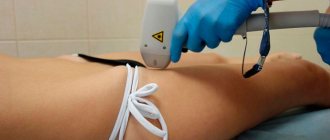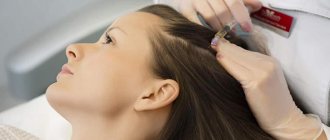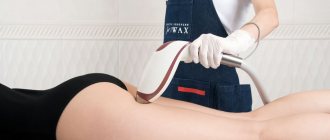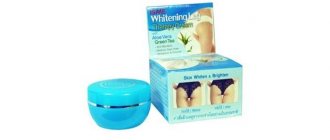Hair removal in intimate places is a rather delicate problem that almost every woman faces. The perfect bikini line is in fashion, and it takes a lot of effort to achieve it. Salon procedures, razors, special creams: all this does not always bring the desired result. Which method should you choose and what should you do to keep your skin smooth and soft for as long as possible? You will learn about this by reading this article.
The perfect bikini line is in fashion, and it takes a lot of effort to achieve it
Epilation of the intimate area: pros and cons
To epilate or not to epilate the bikini area? Some believe that pubic hair protects the genital area from pathogenic organisms and the external environment, while others believe that removing hair is aesthetically pleasing and hygienic. Let's look at the positive and negative aspects of hair removal.
Table: hair removal in the intimate area: pros and cons
| Behind | Against |
|
|
Contraindications
If you have these symptoms, you should absolutely not use hair removal methods. This can lead to infectious diseases and deterioration in general health.
- allergy to the components included in the main product;
- inflammatory process in blood vessels;
- neoplasms on the skin;
- the presence of mechanical damage, irritation and inflammation;
- diabetes .
Depilation of the intimate area is carried out using different methods. They all have advantages and disadvantages. The choice of a specific hair removal method depends on the individual characteristics of the body and the financial capabilities of the client.
Types of intimate hair removal
Intimate hair removal is a whole creative process, thanks to which a girl can show her individuality and sexual spirit. There are several main types of intimate hair removal:
- Classic hair removal is when hair is removed only from visible places (roughly speaking, outside the panties). Classic hair removal does not imply a complete absence of hair.
- Deep bikini is a type of intimate hair removal that is quite common and popular among young girls. Many people consider this design not only hygienic, but also sexy. This type of hair removal involves complete removal of hair from the entire genital area.
- French hair removal is similar to a deep bikini, but in this case a thin strip of hair remains on the pubic area, and all other hair is removed.
Photo gallery: types of intimate hair removal
Hair is removed from the entire intimate area
Hair is removed from outside the panties
Hair is removed everywhere, but a small strip remains on the pubis
Intergluteal space
Additionally, many remove hairs in the intergluteal space. Such hair removal will harmoniously complement the “total bikini” - the intimate area will be completely freed from unnecessary growth.
Of course, each girl decides for herself which option to choose. Usually everyone starts with the classics, and then, having appreciated the benefits of smooth skin, they decide on deep and then total hair removal of the bikini area.
Methods for bikini hair removal at home
To remove hair in the bikini area yourself, familiarize yourself with the intricacies of each method.
Depilatory cream for intimate areas
This method is often mistakenly classified as hair removal; it is one option for hair removal, but it is also excellent for the bikini area. The cream is the best option for people who have no experience in bikini hair removal. The creams are easy to use, affordable, and effective. The depilatory cream contains chemical elements that can cause an allergic reaction. Before use, spread a little product on the wrist area, make sure that the skin is not red. Give preference to a cream with the addition of moisturizing ingredients or oils.
How to use the cream correctly
- Apply the required amount to the area you want to remove vegetation from. Make sure the entire length of your hair is covered with cream.
- Leave the cream for the time indicated in the instructions for it.
- After waiting the required amount of time, rinse off the residue with warm water.
- Apply moisturizer.
How long will the effect last?
Depilatory creams only remove hair that is on the surface of the skin. The hair will begin to grow back 2-3 days after hair removal.
Advantages of hair removal creams:
- fast and easy method;
- painless procedure;
- the method is ideal for beginners;
- The cream will remove hair even from hard-to-reach places.
Cons of hair removal creams:
- the cream may cause rashes on sensitive skin;
- the cream usually has a strong chemical smell that lingers on the skin.
Before and after using hair removal cream
Treatment of the intimate area with an epilator
The epilator is suitable for girls with a high pain threshold. It works by plucking individual hairs from the root using mechanically controlled tweezers. Removing hair with an epilator is painful, but the longer you use it, the less pain and discomfort you experience.
How to use an epilator correctly
Epilators are waterproof and for dry use. In the intimate area, it is preferable to use a waterproof epilator, since removing hair from the genital area is less painful in the shower, after steaming the bikini area well.
- Before epilation, you should trim your pubic hair with scissors to a length of 2–3 mm. This will prevent the hairs from getting tangled during the removal procedure.
- The next step is exfoliation. Walk over the area you need with a soft scrub, after steaming the skin in the shower.
- Place the epilator against your skin without applying pressure. Hair should be removed in the direction of its growth. Movements with the epilator should be fast and confident. The faster you move, the less pain you will feel.
- After epilation, apply a moisturizing gel or cream to the intimate area.
How long will the effect last?
The epilator removes hair from the root, so the smooth skin effect usually lasts up to 3-4 weeks.
Pros of the epilator:
- the effect after hair removal lasts quite a long time;
- possibility of long-term use;
- convenient for travel.
Cons of the epilator:
- painful procedure;
- possible appearance of irritation and ingrown hairs;
- Not suitable for those with very delicate and sensitive skin.
The epilator for the intimate area has several attachments
Wax strips for intimate hair removal
Wax strips are common among women who do not have proper experience in bikini hair removal. If waxing is a difficult process for you, then strips will be an excellent solution. They are sold as a ready-made set. The set consists of the strips themselves and special oil wipes. They wipe the skin to remove any wax remaining after the procedure.
How to use wax strips correctly
- Make sure your pubic hair is long enough (2-3 mm) - if not, the wax simply will not be able to capture the hair for subsequent removal.
- Warm up the wax strip with your hands, rubbing it a little.
- Divide the wax strip into two parts. Place one of them firmly against the area you need.
- Rub the strip for a while along the hair growth.
- With your free hand, fix the area of skin, pulling it slightly, and with your other hand, sharply remove the strip in the direction of hair growth.
- Repeat the procedure as many times as necessary.
- Clean your skin with the cloth provided in the kit.
How long will the effect last?
Wax strips are an effective option to get rid of hair in the bikini area for a long time. They remove hair from the root, leaving the skin smooth for up to 3-4 weeks.
Pros of wax strips:
- an affordable method that does not require large expenses;
- suitable for inexperienced girls;
- long lasting effect after hair removal.
Cons of wax strips:
- painful procedure;
- the wax may not be completely removed from the skin, this causes discomfort;
- bruises may remain after the procedure;
- high risk of irritation and redness on the skin.
The wax strip for the bikini area consists of two parts glued together
Trimmer for removing hair from intimate areas
The trimmer will help you create a contour for your intimate haircut and create an interesting design, but this tool will not be able to completely remove hair.
How to use a trimmer correctly
- Insert the battery or batteries into your device.
- A wide attachment is optimal for a bikini, but the final choice is yours.
- It is better to put a comb attachment on top to cut hair to the desired length.
- Turn on your trimmer.
- Place the device against the bikini area, moving against the hair growth, slightly stretching the skin.
- Change attachments if necessary.
How long will the effect last?
The trimmer does not completely remove hair; it cuts it to the length you need, based on the selected attachment. You won’t be able to achieve the effect of smooth skin, but creating an intimate haircut with a trimmer is quite simple.
Pros of a trimmer for the intimate area:
- painlessness of the procedure;
- the trimmer does not cause skin irritation;
- easy to use;
- convenient for travel.
Disadvantages of a trimmer for the intimate area:
- does not remove hair from the roots, but only shortens it;
- Additional attachments will need to be purchased.
Using a trimmer you can make an interesting haircut in the intimate area
Plucking hair with tweezers in an intimate place
Plucking pubic hair is not a substitute for shaving or waxing this delicate area. Tweezers can serve as a means of correcting an intimate haircut if single hairs remain somewhere after epilation. Tweezers remove hair from the roots, but using it on the entire bikini area is not productive; it is better to choose another method.
How to use tweezers
If after epilation you still have hair in some places, then get rid of it with tweezers. The tweezers must be sterile and free of rust. It is best to have a separate instrument that will be used exclusively in the intimate area.
The advantages of plucking hair with tweezers in an intimate place:
- tweezers remove single hairs;
- accessible method;
- allows you to make your skin smooth by removing hair in hard-to-reach places.
Disadvantages of plucking hair with tweezers in an intimate place:
- painful procedure;
- hair removal takes a long time if there are a lot of hairs;
- Ingrown hairs may appear.
Using tweezers you can remove single hairs
Shaving the intimate area
Shaving is the most accessible and well-known method of hair removal and is one of the methods of depilation.
How to shave your bikini area correctly
- First, cut the hair with scissors to a length of 2–5 mm.
- Apply shaving cream to the desired area.
- While shaving, you need to stretch the skin a little, this will protect you from cuts. Razors only work well on flat surfaces of the skin.
- Place the razor against your skin without pressing on it. Start removing hair first in the direction of hair growth and then in the opposite direction.
- Do not go over the same place with the machine multiple times.
- Be sure to wash the blade when working. A clogged razor will not perform well.
- If there are pimples or wounds on the skin, you should not shave this area.
- At the end of the procedure, apply moisturizer.
How long will the effect last?
The razor cuts off the visible part of the hair, so the effect is short-lived. After 1–2 days, the skin will not be perfectly smooth.
Pros of shaving the intimate area:
- inexpensive and accessible way;
- painless.
Disadvantages of shaving the intimate area:
- hair grows back a few days after the procedure;
- you can cut the skin if you perform the procedure incorrectly;
- risk of ingrown hairs.
Shaving is the most popular way to get rid of hair in the bikini area.
For the most tender
Traditional laser hair removal is mainly suitable for fair-skinned people. Dark-skinned women, tan lovers, as well as the most sensitive girls with a low pain threshold may prefer the advanced laser hair removal technology – Moveo. It differs from the classic one in the specific settings of the device and a special tip, which is complemented by a cooling nozzle.
This technique is suitable for all phototypes, and even a southern tan will not be a contraindication for such hair removal.
Laser hair removal of bikini using Moveo technology (Moveo)
In addition, dynamic hair removal is absolutely painless and does not require the use of anesthetics. This is great news for those who are allergic to pain creams or are simply sensitive.
Main advantages of the technology:
- Versatility. Suitable even for dark-skinned women;
- Rapidity. The procedure takes a minimum of time; several sessions are enough to obtain a lasting effect;
- Safety. There are no side effects;
- Painless. No need to use anesthetic gels.
Epilation of the intimate area in the salon
The procedure for hair removal of the intimate area began to gain popularity back in the 20th century, when open two-piece swimsuits came into fashion. Currently, many beauty salons provide bikini hair removal services. Different methods are used to remove hair:
- waxing;
- sugaring;
- laser hair removal.
Waxing
One of the most popular options for intimate hair removal is waxing.
In the salon, waxing is carried out as follows:
- First, the skin is treated with a disinfectant lotion.
- Next, apply wax heated from 40 to 60 degrees.
- Special paper is placed on top, pressing it tightly with your hand to the skin.
- With a quick movement, the master removes the paper in the direction of hair growth.
- At the end of the procedure, a moisturizer is applied.
Sugaring
A good alternative to waxing is sugaring (epilation with caramel paste). This option is optimal for sensitive skin. Sugaring contains natural ingredients: sugar and lemon juice. Sometimes honey and essential oils are included in the sugar paste, which soften the skin and protect it from irritation.
What you need to know before sugaring.
Two days before the procedure, you need to treat the intimate area with a gentle cleansing scrub. This will make the hair removal procedure less painful, because there will be no dead cells on the skin.
Sugaring of the intimate area in the salon is carried out as follows:
- The bikini area is treated with a disinfectant, then sprinkled with talcum powder (this will help the paste to set better).
- The next step is to apply a sugar mixture preheated to forty degrees against hair growth.
- Sugaring paste is removed sharply, following hair growth.
- At the end of the procedure, the master removes the remaining paste and treats the skin with a soothing agent.
The total duration of the sugar hair removal procedure is 30–40 minutes, and the effect lasts for 3–4 weeks.
Laser hair removal
If you are looking for a way to permanently get rid of hair, then laser hair removal is ideal for you. The laser not only removes hair from the surface of the skin or from the root, it destroys the hair follicle. The number of laser hair removal sessions depends on the type of skin and hair.
Preparation before laser hair removal:
- Two months before the procedure, you should not get rid of hair in the bikini area.
- You should not visit a solarium or sunbathe in the sun 2–3 weeks before the procedure.
- On the day of the procedure, do not apply any cosmetics to the area that will be subject to laser hair removal.
- Make sure you have no contraindications for laser hair removal. It is best to consult a specialist.
You should not resort to laser hair removal procedure under the following circumstances:
- period of pregnancy, lactation;
- cancer;
- varicose veins;
- skin diseases;
- acute infectious diseases.
Laser hair removal in the salon proceeds as follows:
- The specialist first determines your skin and hair type, and based on this, the optimal laser hair removal option is selected.
- An anesthetic is applied an hour before hair removal.
- The laser can only be used on dry and clean skin. The device generates impulses that destroy the hair follicle.
- In between work, the skin is cooled with special means.
Photo gallery: intimate hair removal in the salon
Sugaring is the process of removing vegetation using sugar paste.
Laser hair removal will help you get rid of hair forever
Waxing is a painful but effective method of getting rid of hair in the intimate area.
Rehabilitation
After classical laser hair removal, it is forbidden to expose the treated area to sunlight, as well as to visit a bathhouse, sauna, or swimming pool. After MOVEO hair removal, you can go to the beach a day later.
In the intervals between sessions, only a razor can be used to remove emerging hair; all other methods of removing stubble are prohibited. Since before the next procedure there must be hairs (hair follicles) on the body, which are the target for the laser.
Pain relief during bikini hair removal
Home methods for pain relief are quite simple. They will help make the hair removal procedure more tolerable and comfortable.
Pain relief without the use of special means:
- Before the procedure, you can apply ice to the intimate area for 2-5 minutes, so the skin will become less sensitive.
- During epilation, stretch the skin, so the procedure will be less traumatic.
- Remove hair from the bikini area after pre-steaming the skin.
If you have a low sensitivity threshold, then use one of the painkillers.
- Emla cream. An effective drug that can reduce sensitivity in the bikini area. It should be applied an hour before the procedure. Spread a small amount (1–2 grams) over the intimate area, and place cling film or a plastic bag on top. It is in this form that you need to wait 60 minutes, then proceed to hair removal.
- Cream Light Dep. This cream can be purchased in specialized stores. It blocks pain receptors, making the hair removal procedure comfortable and painless. This product is applied to the intimate area 20–30 minutes before the start of the procedure. The duration of action of the Light Dep cream is 2.5 hours.
- Cream Dr. Numb. A well-known pain reliever during hair removal. It acts quickly, blocking the nerve impulse. The effect lasts 2–3 hours.
Epilator
The principle of operation of epilators is to capture and then pull out hairs using special mechanisms. You can treat the bikini area with the device, but you need to take into account that the process is painful. The most unpleasant sensations are caused by the first session. Repeated depilation is usually easier to tolerate.
Before depilating the bikini area at home, take a bath or shower, dry and degrease the skin surface. During the procedure, the epilator is held vertically to the treatment site. Short intermittent movements are directed against hair growth.
Using epilator attachments with a cooling or massage effect, which are often included in the kit, will reduce discomfort. Local anesthetic drugs are also used for pain relief.
The advantage of mechanical hair removal is the ease of manipulation and the ability to remove short hairs with a length of 1 mm.
How to relieve irritation after epilation of the intimate area
If your skin turns red and itchy after hair removal, this may cause further acne and ingrown hairs. Therefore, having noticed the first signs of skin irritation, it is necessary to prevent unpleasant consequences. This can be done using available products that are available at home or sold in any pharmacy:
- Tea tree oil. Tea tree oil is an effective and popular remedy. Add 10-15 drops of tea tree oil to a glass of cold water. Wipe the affected areas by soaking a cotton pad in the resulting compress.
- Chamomile collection. To relieve inflammation and remove redness from the skin, purchase chamomile tea at the pharmacy. Steam it with boiling water (1 tablespoon of chamomile is enough for a glass of water). Let the product brew and cool slightly, then soak a cotton pad in the resulting infusion and wipe the desired areas of the skin.
- Aloe vera. If you have this plant at home, use its stem. You need to cut off a small shoot of the plant, squeeze the juice out of it, and then wipe the affected area of the skin with it. Aloe vera gel can also be purchased at the pharmacy.
Some pharmaceutical products can also help restore skin after hair removal. These include:
- Panthenol. The cream or gel is applied to the skin without rinsing off. You can use it several times a day; it perfectly soothes the skin, restoring damaged areas.
- Miramistin. It is an effective antimicrobial and sedative. Miramistin does not dry the skin, it restores it after any type of hair removal. It should be applied immediately after shaving, spraying onto the desired area.
- Boro plus. This is a cream that can be purchased at any pharmacy. It has a greasy consistency and can remove skin irritation, restore and nourish it in one go. It is distributed with massage movements over the damaged area.
Bikini hair removal during pregnancy
Not all types of hair removal are safe during pregnancy. This is a special period in a woman’s life, so you need to pay special attention to even such a routine procedure as hair removal of the bikini area:
- Shaving is a completely safe way to get rid of unwanted hair in the genital area while pregnant. So, if this is your usual method, then you can continue to use it.
- Plucking a couple of hairs with tweezers is quite acceptable, but you shouldn’t treat the entire bikini area with an epilator. Elevated hormone levels can lead to various types of skin problems. Sensitivity increases during pregnancy, and the epilator is a painful tool that can cause uterine contractions and, as a result, premature birth or miscarriage.
- Waxing also causes pain, which means there is a risk of uterine tone, which is dangerous during pregnancy. If you have previously used this method and want to continue waxing sessions, then consult with the doctor who is monitoring your pregnancy. Perhaps waxing is completely contraindicated for you.
- Although sugaring is considered a more gentle procedure, this does not mean that it is safe to perform sugar hair removal while pregnant. Consultation with a doctor from a women's clinic is required. The specialist will assess your physical condition, prescribe the necessary tests, and then be able to advise the optimal hair removal method for you.
- Depilatory creams during pregnancy are a rather controversial issue. The main threat to pregnant women is the presence of chemicals that can provoke an allergic reaction. It is better not to resort to using any kind of depilatory creams.
- Laser hair removal is not recommended during pregnancy. Pigmentation may occur due to increased sensitivity and receptivity of the skin. Plus, laser hair removal is not always painless, and using an anesthetic during pregnancy is not always acceptable.
Photoepilation
Photoepilation, unlike other types of hair removal, can permanently remove unnecessary hair in just a few sessions. Epilation with a photoepilator is very painful, especially in intimate places. Before starting the process, it is necessary to prepare and numb the area. To do this, an anesthetic cream is applied to the intimate area, which reduces discomfort.
This hair removal method appeared relatively recently, so not everyone knows how it works. During photoepilation, the skin is exposed to light waves. Under the influence of flashes of light, hair follicles begin to collapse. After the first procedure, about 25 percent of hair disappears.
The session lasts about 20 minutes, but it is worth remembering some rules before starting photoepilation.
- Hair is not removed the first time. Be prepared for the fact that at first you will have to grow your hair to a certain length. You will not leave the specialist with absolutely smooth skin, as, for example, after waxing. To achieve results, about 8 procedures are required. There are a large number of contraindications, so first of all you should consult your doctor.
After the procedure, you cannot sunbathe, swim in the pool, or visit the bathhouse or sauna for 5 days. This time is necessary for the skin to recover. There are a large number of contraindications, so first of all you should consult your doctor.











